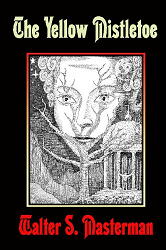Fri 5 Mar 2010
A Review by Tim Mayer: WALTER S. MASTERMAN – The Yellow Mistletoe.
Posted by Steve under ReviewsNo Comments
WALTER C. MASTERMAN – The Yellow Mistletoe. Jarrolds, UK, hardcover, 1930. E. P. Dutton, US, 1930. Reprint edition: Ramble House, 2009.

#7. The Yellow Mistletoe by Walter S. Masterman:
“A wild one. Masterman was another of those detective writers who at times broke away from formula. This one reads like a cross between Monk Lewis and Sax Rohmer.”
I think KEW enjoyed this one for its sense of adventure.
It begins with a murder in the London subway in 1930. The Rev. George Shepherd was on his way to deliver important documents to Scotland Yard when he’s found dead at the foot of a stairway. The official cause is an accidental fall.
Sir Arthur Sinclair, a retired police investigator soon takes an interest in the case. He discovers the Rev. Shepherd was serving in a small town in Derbyshire, where he’d relocated to after his second marriage. The Reverend was survived by a son (Ronald) from the first marriage and daughter (Diana) from the second. Both of his wives had died, the second was found frightened to death in a wooded area near his church.
Rev. Shepherd’s son and daughter soon make an appearance. We don’t get much of a description of either of them (descriptions of the characters is one of the few weak points of the novel), but we are told his daughter possesses golden hair and is the very image of her late mother (also named Diana).
At this point the novel bogs down a bit as the step-siblings busy themselves dealing with the death of their father. Sir Arthur pops in and out and more characters are introduced. There’s an Italian restaurateur named Ganzani who tries to “buy” Diana for parties unknown. Carstairs, a chum of Ronald from his college days, makes an appearance. He has interests of his own in Diana.
There’s a rich uncle R. Reginald Shepherd, who seems to know more about the reverend’s dead wife than he will admit, but he soon dies also. And we are introduced to Dr. Smart, a research physician. Lastly, there’s a smart set, Ralph and Doris Gorringe, ready to play tennis at the drop of a straw hat. Masterman has an irritating tendency to introduce a lot of characters quickly with similar names.
It’s the half-point where the book turns from a conventional 1930’s mystery novel to a tale of high adventure. Diana suddenly disappears with Carstairs. It’s not clear if she was kidnapped or went willingly.
Her step-brother Ronald decides to pursue her across Europe with the Gorringe kids in tow. The trail first leads to an ancient Italian town near Lake Nemi, then across the mountains of Bulgaria. Along the way they discover Carstairs is the leader of a lost tribe of a Greek fertility cultists, which survive in a hidden valley near the Black Sea. They practice unspeakable rites at spring. And the cult has designs on Diana, whose mother fled from the valley.
It’s up to the mysterious Sir Arthur to save the day.
Obviously Masterman studied George Frazer’s The Golden Bough for the ancient Greek survivalists in the lost valley. There’s plenty of references to the “priest-king” and Diana of the Woods. It wasn’t George Lucas alone who found Frazer useful for a work of fiction.
I give credit to Masterman for a brief but well thought out depiction of an isolated lost race. Instead of portraying them as pure representatives of the noble past, he points out all the problems caused by in-breeding. Even the crops are having trouble .
As for the title, it refers to a particular plant the initiates of the Greek cult use to identify each other. Sprigs of yellow mistletoe pop-up all over the place in the first 100 pages.
Ramble House has done of a fine job of getting this book and other novels by Walter Masterman back into print.
Editorial Comments: This review first appeared on Tim’s Z7HQ blog. He’s graciously allowed me to reprint it here as a way for me to introduce him to you, if you haven’t stopped by there already.
Besides reviewing books from Karl Edward Wagner’s three lists of Best Horror Novels (13 each in the three following categories: Supernatural Horror, Science-Fictional Horror, Non-Supernatural Horror), Tim covers pulp fiction (Operator 5, Doc Savage, etc.), mystery fiction (Fredric Brown, John Dickson Carr and so on), and numerous titles of a similar nature. Drop by and say hello.
And, if you think you’ll find a copy of this book in either of its original UK or US editions, you’ll have another think coming. There’s not one offered for sale on the Internet. It’s the Ramble House edition or nothing.